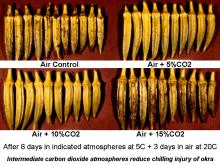Product Description
Maturity and Quality
Okra pods are immature fruits and are harvested when they are very rapidly growing. Harvest typically occurs 3 to 7 days after flowering. Okra should be harvested when the fruit is bright green, the pod is fleshy and seeds are small. After that period, the pod becomes pithy and tough, and the green color and mucilage content decrease.
Okra pods should be tender and not fibrous, and have a color typical of the cultivar (generally bright green). The pods should be well formed and straight, have a fresh appearance and not show signs of dehydration. Grade is U.S. no. 1. Pods are packed based on length with Fancy, Choice and Jumbo designations for size categories. Okra should be free of defects such as leaves, stems, broken pods, insect damage, and mechanical injury. The tender pods are easily damaged during harvest, especially on the ridges and this leads to unsightly brown and black discoloration. Quality losses that occur during marketing are often associated with mechanical damage, water loss, chilling injury, and decay.
Postharvest Handling and Storage
7-10°C (45-50°F)
Very good quality can be maintained up to 7 to 10 days at these temperatures. If stored at higher temperatures, the pods lose quality due to dehydration, yellowing and decay. When stored at lower than recommended temperatures, chilling injury will be induced (see physiological disorders). Chilling symptoms include surface discoloration, pitting and decay. Okra can be successfully hydrocooled or forced-air cooled.
Okra pods have very high respiration rates.
| Temperature | 5°C (41°F) | 10°C (50°F) | 15°C (59°F) | 20°C (68°F) |
| ml CO2>/kg·hr | 27-30 | 43-47 | 69-72 | 124-137 |
To calculate heat production multiply ml CO2/kg·hr by 440 to get Btu/ton/day or by 122 to get kcal/metric ton/day.
Weight loss is very high in immature okra pods and cultivars may vary in rate of water loss. A very high relative humidity (95-100%) is needed to retard dehydration, pod toughening, and loss of fresh appearance.
Okra pods have low ethylene production rates
Okra is not stored in modified atmospheres commercially. At recommended storage temperatures, CO2 concentrations of 4-10% can help maintain green color and reduce discoloration and decay on damaged pods. CO2 concentrations higher than 10% can lead to off flavors. Low O2 concentrations (3-5%) reduce respiration rates and may also be beneficial.
Disorders
Chilling injury. The typical symptoms of chilling injury in okra are discoloration, pitting, water-soaked lesions and increased decay (especially after removal to warmer temperatures, as during marketing). Different cultivars may differ in their susceptibility to chilling injury. Calcium dips and modified atmospheres have been reported to reduce chilling symptoms.
Freeze damage. Occurs at temperatures of -1.8°C (28.7°F) or below.
Decay on okra can be due to various common bacterial and fungal organisms, but chilling and injury-enhanced rots are probably the most common causes of loss. Rhizopus, Geotrichum and Rhizoctonia fungal rots as well as bacterial decays due to Pseudomonas sp. have been reported to cause postharvest losses.




